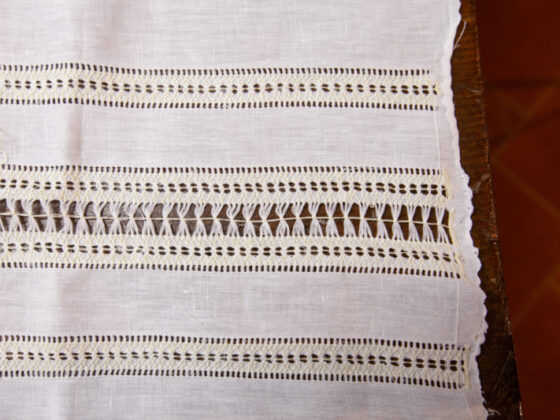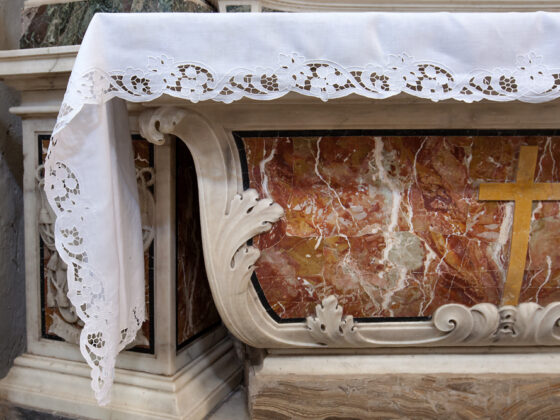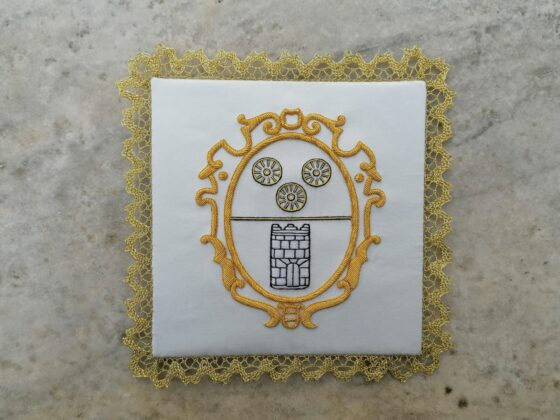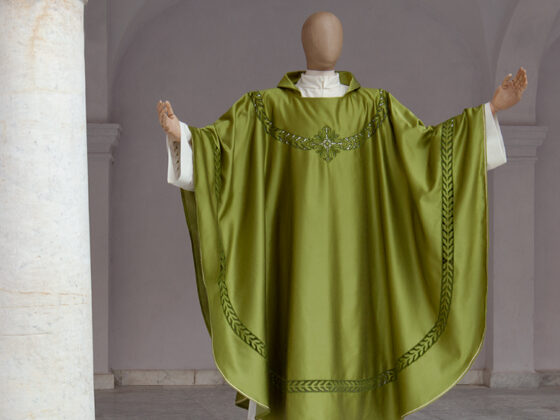Many of us were baptized as infants, and only through photographs and the stories of our parents can we reconstruct that day. Among the many memories, the most tangible is certainly the white garment we wore, which is now kept in some drawer. During the Easter Night, the baptismal promises made for us that day are renewed, and sometimes we are fortunate enough to witness the Baptism of someone who will make those promises for the first time. It will be like wearing that white garment once again, the story of which we want to share with you today.

Where does the rite of Baptism originate?
The ritual of Baptism dates back to the early centuries of Christianity. In the second half of the 4th century in Jerusalem, the person being baptized would enter the vestibule of the baptistery without shoes. Turning west, the baptized person would express their renunciation of Satan and evil, and after receiving the sacred oils, they would profess the Creed, turning east, known as the redditio symboli, because it was the first time the baptized person personally confirmed the faith they had received. Then, the blessing of the water would take place. The Apostolic Constitutions, texts from around 380 AD intended as a guide for the clergy, also include a special prayer that accompanied this moment: “Look, O Lord, from heaven, and sanctify this water, give it such grace and such power, that all who are immersed in it, as prescribed by Christ, may be crucified, die, be buried, and rise with Him to adoption, which He has merited for them, making them die to sin and live to righteousness.”
At that point, the baptized person could immerse themselves in the baptistery, accompanied by their godfather if male, or godmother if female. The priest would then pour water on the person’s head, baptizing them as Jesus had taught: “In the name of the Father, the Son, and the Holy Spirit.”

Why is Baptism often celebrated on Easter night?
In the Mystagogical Catecheses, Cyril of Jerusalem writes, “You recited the saving profession of faith and then were immersed three times in the water and came out. This was to express the three days that Christ spent in the tomb… In that very moment, you died and were born; the saving water (of baptism) was both tomb and mother” (II, 4). This passage explains why during the Easter Vigil we are called to renew our baptismal promises and the meaning of the celebration of Baptism today for many children and adults on Easter night.
Baptism, therefore, is the sacrament through which we fully participate in the death and resurrection of Jesus. Paul writes, “Buried with Him in baptism, in Him you were also raised through faith in the power of God who raised Him from the dead…” (Col 2:12). The shape of the baptistery also reinforces the connection between baptism and resurrection: “[…] it was fitting that the hall of the Sacred Baptistery should have eight sides, because the true salvation was granted to the people when, on the dawn of the eighth day, Christ rose from the dead” (St. Ambrose, 4th century AD).
This is why the night of Easter, in which Jesus passes from death to life, is the ideal night to celebrate this sacrament.

Why does one receive a white bib during Baptism?
The white garment is an element that frequently appears in the scriptures and carries with it a positive sense of purity, light, and joy. Some passages are particularly famous. John, while describing the resurrection, speaks of “two angels in white garments” (John 20:12); or during the episode of the Transfiguration, Mark says, “and His clothes became dazzling white, whiter than anyone in the world could bleach them” (Mark 9:3). The ritual of giving a white garment to the baptized child was not used immediately but was introduced around the 4th century. It draws from the catechumenal tradition of wearing a white garment once leaving the baptistery. Back then, the garment was worn throughout the Easter season until the Sunday in albis.
Today, in the rite of Baptism, the gesture of presenting the garment is accompanied by the formula that the priest recites: “You have become a new creation and have been clothed with Christ. This white garment is a sign of your new dignity: with the help of the words and examples of your loved ones, wear it without stain for eternal life.” (Roman Ritual, Rite of Baptism of Children, 72, p.67).
White is a color that evokes purity and innocence, typical characteristics of the child who, just born, receives the sacrament of Baptism but also of the adult who, after a path of preparation, is clothed with Christ and begins a new life. Wearing the white garment is like wearing a wedding dress: it expresses one’s desire to welcome Jesus and fully enter into the Christian community. Just as the handing over of the lit candle, the white garment is also a sign that entrusts the parents and the godfather or godmother with the responsibility to pursue what the garment represents, helping the child in their Christian life journey. The white garment is usually given by the celebrant priest or by family members.

How does the baptismal bib look like?
It is not necessary for the child to be dressed in white during the ceremony. It is the garment that will be given to make the child shine in white. The baptismal bibs from Arte Ricami reflect the most commonly used model in Italy, which is a white dress that can be comfortably worn over the head without the need to put the sleeves on. Our decorations draw inspiration from the symbolism of the Holy Spirit and the cross on which Jesus conquers death.
They are made of pure linen, so they do not make the child sweat during the ceremony.
If you would like more information, please write to us at info@artericamiliturgico.com.
We wish you to live intensely the Easter festivities in your communities, wearing again, even if only metaphorically, your white Baptismal robe.
Notes:
Biavaschi, S.: La vera fede. Piccolo strumento di formazione alla luce del magistero
Cirillo di Gerusalemme: Catechesi mistagogica II,4.
Rituale Romano, Rito del battesimo dei bambini, p.67, art.72




